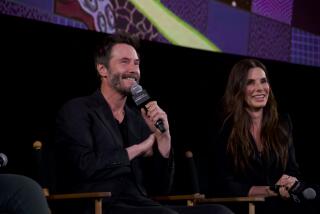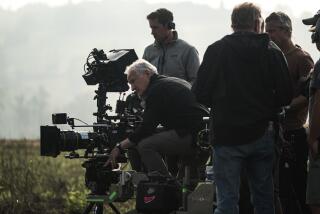Filmmakers: Behind the wheel of a very human race in âFord v Ferrariâ
James Mangoldâs âFord v Ferrariâ features immersive racing sequences achieved with detail and daring. Yet the filmmakers agree it would have been a non-starter if not for a focus on story and character. Mangold, editors Andrew Buckland and Michael McCusker, sound designer David Giammarco, production designer François Audouy and cinematographer Phedon Papamichael shared some of the secrets of how they put viewers in the cockpit for the famed 24 hours of Le Mans, 1966.
Mangold: Iâm not a big racing guy ... Iâm fascinated by the struggle, before computer models, to build something from nothing that can outperform anything that exists. And youâve got to do it with your hands, and youâve got to put your body at risk. You donât know if youâve built something that will even stop, until you put yourself behind the wheel.
Southern California locations play a key role in âFord v Ferrari,â starring Matt Damon and Christian Bale as American race car builder Carroll Shelby and English race car driver Ken Miles.
Giammarco: For Jim, itâs all about story. We were fortunate enough to record period-correct GT-40s, and a Ferrari from that time. Sonically, if we can get it accurate, itâs great, but itâs really more important to tell the story.
Mangold: The racing would seem like some Epcot-Imax demonstration video if it wasnât for your connection to the characters [leads were played by Matt Damon as Carroll Shelby and Christian Bale as driver Ken Miles]. I try and make everything as specific as if it were a dialogue scene.
Audouy: From the very beginning, the movie had this enormous third-act racing sequence that is a third of the movie: the Le Mans race in 1966. Itâs probably the most famous race course in the world. Itâs an 8½-mile course that goes across French countryside. We settled on an airport in Agua Dulce for four or five months. [Production shot the countryside scenes outside of Atlanta and a racetrack in Savannah.]
Mangold: To communicate what makes Le Mans special, we couldnât just do a spectacular 20-minute race with a series of cuts to the scoreboard, then time cuts, then itâs over. It was something you had to live in and endure in the same way that the race is a marathon in real life. Itâs âI want to know what theyâre feeling and what theyâre doing and why.â I want the shots to tell the story of how Iâm getting around the car in front of me, how Iâm compensating for the fact my brakes are not working.
Papamichael: We like to go close with wide lenses. Itâs like when we did the Johnny Cash story [Mangoldâs âWalk the Lineâ]; itâs not from the audienceâs perspective, itâs not long lenses.
James Mangoldâs auto racing drama starring Matt Damon and Christian Bale is classical filmmaking at its finest.
Giammarco: Jim wanted us to be in those cars with [the characters]. The suspension rattling and shaking all around, we wanted to create that environment, what itâs like to be inside a car thatâs on the verge of flying off the track. The things that rattle in the car, the vibrations, the rain on the roof. Inside the GT-40, thereâs this little ring dangling on the window latch. So our Foley editor, she cut these tiny things, theyâre so small, but [the sound] pops right through. That was a thing he loved: Little, tiny tinkling while the suspension was groaning and lurching and the engine was roaring.
Audouy: We ended up building about 34 cars from scratch. In re-creating them, you want as much detail as possible to make them feel real. With the Ferraris, we hand-applied hundreds of little red rivets. We added the painstaking, loving details â the patches on the seat belts on the racing harnesses, the emblems on the steering wheels, the stickers on the outside.
McCusker: One reason it feels so visceral is those are real cars; theyâre really in those cars. They couldnât actually go 200 mph; some could go maybe half that. We applied editorial techniques to speed them up.
Papamichael: These cars look most dynamic when youâre inches from them, low to the ground, with a wide-angle lens that really conveys all the speed. You see the ground. The cameraâs inches away, another car comes into frame and almost clips the matte box [of the camera].
Buckland: Being in the cockpit of the GT-40 with Miles â even if we cut outside the car for a moment to demonstrate its maneuverability, itâs still a very subjective experience.
Mangold: We built special rigs where the actors would ride but werenât necessarily driving; the driver would sit above them or to the side so we could take them over 100 mph through a slalom of cars.
Papamichael: Itâs a minimal amount of green screen. The stunts are designed to have the cars physically inches away from each other. When you see a car spin off in the background or through his POV in the windshield, thatâs all choreographed stunt driving and mechanical special effects. Theyâre going 90 mph, and we were in pursuit vehicles, hanging on the edge of our seats as well; it really informed the performances.
Mangold: At speed, thereâs a vibration to the whole chassis. Thereâs particulate in the air. Wind coming in every crack and crevice in the car. Itâs not just that it looks better [than green screen]; the acting is better because they have more to balance.
Giammarco: There were moments where we pulled sound out, those internal moments for the character.
Mangold: The Ken Miles who gets in the car at the start of Le Mans is not the same character who gets out of the car at the end. I could give you technical stuff, but thatâs really why it works. Everyone has an arc during the action, so the action doesnât become a kind of eye candy or ear candy to occupy you until the next âacting scene.â
McCusker: I was asked, âWhatâs it like cutting a car movie with characters in it?â Itâs actually a character movie with cars in it.
Mangold: The movie is ultimately about intimacy, friendship and grieving and grace and the kind of brotherhood of men and women who accomplish things, and not about the outcome of one specific race, which is more of a cinematic convention but not really what life is about.

Featurette on James Mangoldâs racing drama, âFord v Ferrariâ (2019)
More to Read
Only good movies
Get the Indie Focus newsletter, Mark Olsen's weekly guide to the world of cinema.
You may occasionally receive promotional content from the Los Angeles Times.











